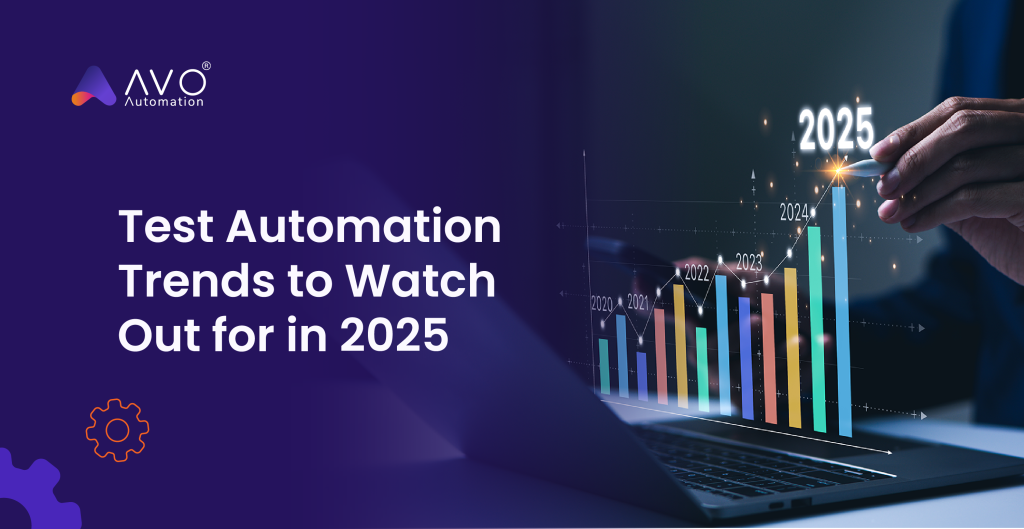The software testing landscape is undergoing an unprecedented evolution as businesses strive to deliver robust, high-quality applications in record time. Test automation, once seen as a supplementary tool, is now a strategic enabler, unlocking innovation and operational excellence. As we move into 2025, it becomes a necessity for businesses to embrace emerging trends to thrive in a highly competitive digital economy.
Here’s a closer look at the key trends shaping test automation in 2025 and their implications for businesses focused on quality, agility, and innovation.
1. AI-Powered Testing: Intelligence Meets Precision
Artificial Intelligence (AI) continues to redefine how testing is conducted by introducing unprecedented levels of accuracy and adaptability.
- Dynamic Maintenance: Self-healing automation scripts that adapt to application changes ensure minimal manual intervention.
- Proactive Risk Mitigation: AI tools predict high-risk areas in code, enabling teams to address potential failures before they occur.
- Comprehensive Test Coverage: Smart algorithms identify gaps in test scenarios, enhancing efficiency without redundancy.
AI-powered testing doesn’t just optimize processes—it redefines quality assurance as a value-driven, intelligent operation.
2. Human-Centric Exploratory Testing: The Power of Perception
Even with advancements in automation, human intuition and creativity remain irreplaceable. Exploratory testing, which focuses on uncovering usability and edge-case issues, is becoming increasingly vital.
- Contextual Insights: Unlike scripted tests, exploratory testing adapts to the unique nuances of applications, uncovering subtle flaws.
- Enhanced User Experience: By stepping into the end-user’s shoes, testers evaluate software from a human perspective, ensuring intuitive and seamless interfaces.
- Collaboration with Automation: Human-centric insights complement AI tools, balancing the precision of machines with the ingenuity of human testers.
In 2025, exploratory testing will continue to play a pivotal role in delivering applications that resonate with real-world users.
3. Shift-Left and Shift-Right Testing: A Balanced Quality Approach
Testing is increasingly integrated across the entire software development lifecycle, emphasizing both early defect detection and continuous improvement post-deployment.
- Shift-Left integrates static code analysis and unit testing in the development phase, reducing costly downstream defects.
- Shift-Right uses production data and user behavior to refine and enhance software, ensuring resilience in real-world scenarios.
This balanced approach enhances quality while fostering a culture of collaboration across teams.
4. Security Testing: Guarding the Digital Frontier
As cybersecurity threats grow in sophistication, security testing has evolved from a specialized task to a core business imperative.
- Integrated Security: Automated security checks embedded within CI/CD pipelines ensure vulnerabilities are addressed throughout the development lifecycle.
- Continuous Monitoring: Tools equipped with advanced threat detection algorithms identify and mitigate risks in real time.
- Building Trust: Rigorous security validation not only protects data but also strengthens customer confidence in the product.
In 2025, businesses that prioritize security testing will set themselves apart by delivering safe and reliable software.
5. Low-Code/No-Code Test Automation: Democratizing Testing
Low-code/no-code platforms are leveling the playing field in test automation by empowering non-technical team members to actively participate in quality assurance.
- Simplified Interfaces: Drag-and-drop tools enable rapid test creation, reducing dependency on specialized skills.
- Cross-Functional Collaboration: Business users, product owners, and testers can work together seamlessly to ensure comprehensive coverage.
This trend not only accelerates time-to-market but also fosters greater inclusivity in testing processes.
6. Comprehensive Mobile and Cloud Testing: Meeting Modern Demands
With mobile-first and cloud-native applications becoming the norm, comprehensive testing strategies are essential to ensure performance and reliability.
- Mobile Testing: Automation tools validate applications across diverse devices, screen sizes, and operating systems, ensuring consistency in user experience.
- Cloud Testing: Testing cloud-based applications focus on scalability, performance under varying loads, and interoperability across hybrid environments.
- Real-World Conditions: Simulations of network conditions and user scenarios ensure applications perform seamlessly in all situations.
Businesses that excel in mobile and cloud testing will be better equipped to meet the demands of an increasingly connected audience.
7. Hyperautomation: Scaling QA with Intelligence
Hyperautomation integrates AI, robotic process automation (RPA), and analytics to create end-to-end automation solutions.
- Real-Time Insights: Integrated tools provide actionable data to monitor and improve system performance.
- Unified Ecosystem: Automation connects disparate testing tools into a single, streamlined workflow.
This approach optimizes resource utilization and accelerates the pace of innovation.
8. IoT Testing: Quality in a Connected World
IoT ecosystems demand rigorous testing strategies that account for the unique challenges of interconnected devices.
- Simulating Real-World Scenarios: Digital twins replicate IoT environments, enabling comprehensive testing without physical setups.
- Security Focus: Robust protocols ensure data integrity and safeguard against unauthorized access.
- Interoperability: Ensuring seamless interaction between diverse devices and protocols is a critical priority.
IoT testing is crucial to maintaining operational excellence in industries ranging from healthcare to smart manufacturing.
9. Sustainability in Testing: Quality with Responsibility
Sustainability is no longer optional—it’s a business imperative. Testing practices are evolving to reduce their environmental impact while maintaining operational efficiency.
- Energy Efficiency: Cloud-based testing and optimized execution cycles lower energy consumption.
- Reduced Hardware Waste: Virtual environments replace physical test labs, aligning with eco-friendly goals.
- Cost Optimization: Sustainable practices often result in leaner, more efficient operations.
Sustainable testing not only reflects corporate responsibility but also enhances long-term viability.
10. End-to-End Testing: Ensuring Seamless Workflows
End-to-end (E2E) testing validates every aspect of an application, from user interactions to backend functionality.
- Synthetic Data Generation: Automated tools simulate real-world workflows to uncover hidden issues.
- Comprehensive Observability: Integrated dashboards provide insights into system performance, ensuring production readiness.
E2E testing delivers a holistic view of quality, ensuring applications meet user expectations and business goals.
11. Data-Driven QA: Insights Driving Innovation
Testing strategies are increasingly informed by data, enabling more precise decision-making and improved outcomes.
- User Behavior Analytics: Real-world data informs test strategies, ensuring alignment with customer needs.
- Historical Trends: Past performance data predicts and mitigates risks, enhancing reliability.
This trend underscores the importance of leveraging actionable insights for strategic advantage.
12. DevTestOps: Collaboration for Continuous Improvement
DevTestOps bridges the gaps between development, testing, and operations, fostering a unified approach to quality.
- Integrated Pipelines: Automated testing within CI/CD workflows ensures rapid and reliable deployments.
- Unified Metrics: Centralized dashboards provide stakeholders with visibility into key performance indicators.
DevTestOps enables faster releases while maintaining a high standard of quality.
Charting a Path to Excellence in 2025
The trends outlined here represent more than just technological advancements—they reflect a shift in how organizations view quality assurance as a driver of business success. For senior executives and testing enthusiasts, embracing these changes is not only strategic but essential.
Partner with Avo for the Future of Testing
Avo Automation is at the forefront of enabling intelligent, no-code test automation with Avo Assure. Designed to align with these emerging trends, Avo Assure simplifies complex testing processes while delivering precision and scalability.
Discover what Avo can do for your QA strategy.
Schedule a demo today and take the first step toward flawless software delivery.

